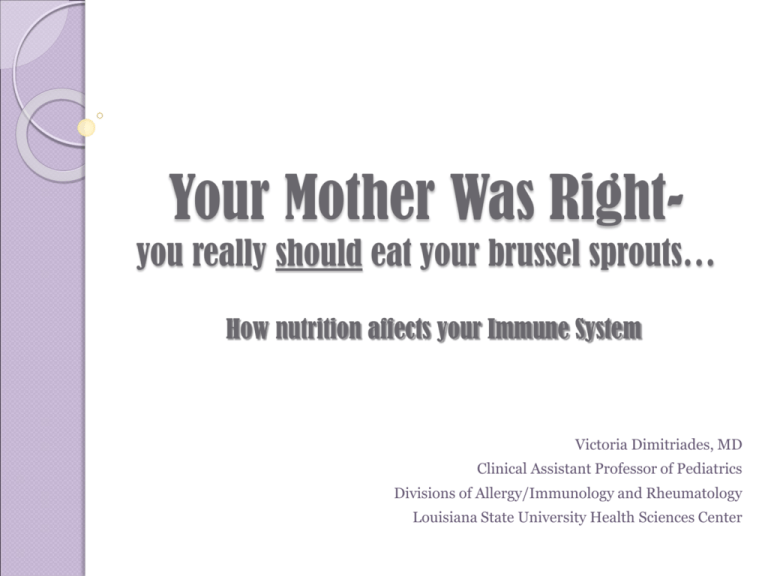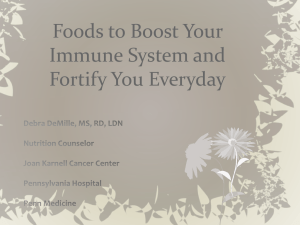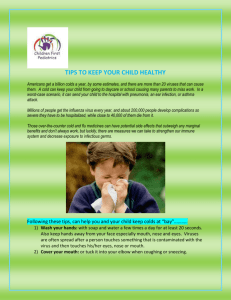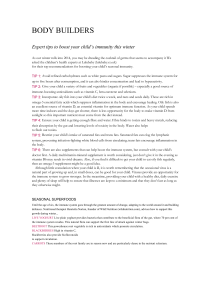Immunity and Nutrition - Immune Deficiency Foundation
advertisement

Your Mother Was Rightyou really should eat your brussel sprouts… How nutrition affects your Immune System Victoria Dimitriades, MD Clinical Assistant Professor of Pediatrics Divisions of Allergy/Immunology and Rheumatology Louisiana State University Health Sciences Center Disclosures I have nothing to disclose, other than my expertise in eating. Complement System T cell Immunity Phagocytes Immune Function Mucous Membranes B cell Immunity Nutrition-Immunity link Macronutrient deficiency ◦ Protein, Calories ◦ Malnutrition is the most common cause of immune deficiency world-wide Micronutrient deficiency ◦ Elements, Vitamins Overnutrition ◦ Excess of macronutrients Protein-energy malnutrition Causes Limited food access Chronic disease Chronic Pain Dental/Feeding issues Medications Severe dieting HAS Clinical Guidelines 2007 Protein-energy malnutrition Innate Immunity Impaired phagocyte function Adaptive Immunity T cells Decreased numbers and function Increased susceptibility to opportunistic infections Micronutrients Iron Zinc Copper Selenium Vitamins Micronutrients- Iron Aids in T cell development Generates some “reactive oxygen species” to kill pathogens Micronutrients- Iron Deficiency associated with: Anemia, paleness, fatigue Infections Immune issues Reduced phagocyte activity Impaired T cell response Risk of parasite and Candida infections Reduced immunoglobulin levels Micronutrients- Iron Supplementation Recommended: 7-18mg/day Micronutrients- Zinc Stimulates T cell production and subtype switching Stimulates complement system Stimulates phagocytes Reduction in risk of pneumonia Reduction in common cold symptoms Reduction in infectious diarrhea (worldwide) Antioxidant/Inflammatory Control Micronutrients- Zinc Deficiency associated with: Skin lesions, hair loss Loss of taste and smell, diarrhea Infections, poor wound healing Immune issues Increased susceptibility to infections (skin and GI system) Impaired phagocytosis Impaired NK cell activity Low T and B cells Micronutrients- Zinc Supplementation Recommended daily dose: 3-11 mg/day of elemental zinc Micronutrients- Copper Promotes T and B cell responses ◦ IL-2 production Promotes phagocyte function Micronutrients- Copper Deficiency associated with: Neutropenia, anemia Neurologic issues Immune issues Low white blood cells Reduced T cell responses Reduced phagocyte responses Neutropenia Micronutrients- Copper Supplementation Recommended: 350-900 mcg/day Micronutrients- Selenium Antioxidant effects Promotes production of limited reactive oxygen species (ROS) to fight infections Stimulates general immune responsiveness T and B cell activation Cytokine release Micronutrients- Selenium Deficiency associated with: More severe effects of viral infections Muscle aches Immune issues Loss of antioxidant host defense Decreased white blood cell and NK cell function Micronutrients- Selenium Supplementation Recommended daily: 20-55 mg/day Vitamin A Supports structure and function of mucosal cells of eyes, lungs, gastrointestinal tract Promotes response to bacterial infections Affects growth and function of B cells Affects activation of T cells Vitamin A Deficiency associated with: Dry eyes, night blindness Diarrhea Respiratory infections Fat malabsorption Vitamin A Immune issues: Loss of structure/function of cells on mucosal surfaces Impaired resistance to infections, especially gastrointestinal Diminished function of innate immunity Impaired B and T cell responses Vitamin A Supplementation Recommended: 1000-3000 IU/day Vitamin B B1- thiamin B2- riboflavin B3- niacin B5- pantothenic acid B6- pyridoxine B7- biotin B9- folic acid B12- cyanocobalmin Vitamin B- all B1- thiamin ◦ Aid in antibody responses B2- riboflavin ◦ Aid in antibody responses B3- niacin B5- pantothenic acid ◦ Aid in production and release of antibodies B6- pyridoxine ◦ Aids in T and B cell production and maturation B7- biotin B9- folic acid ◦ Aids in T cell production and maturation B12- cyanocobalamin ◦ Promotes NK cell activity, aids in T and B cell production Vitamin B- all Supplement ◦ Range dependant on each vitamin Vitamin C Antioxidant effects Protects cells from reactive oxygen species (ROS) made by the body to control infections May have anti-viral activity May aid in symptoms of common cold because of ROS function on surface of airway and lung epithelium Improvement in both innate and adaptive immunity function Vitamin C Deficiency associated with: Purpura/petechiae Poor wound healing (scurvy) Immune issues: Impaired collagen synthesis for barriers Impaired antioxidant performanceincreased free radical production Vitamin C Supplementation Recommended: 75-90 mg/day Vitamin D Necessary for phagocytic activity Limits inflammatory response promoted by specific T cell subtypes Promotes wound healing Vitamin D Deficiency associated with: Rickets Autoimmune diseases Diabetes, type I Atopic diseases Vitamin D Immune issues: B cells ◦ Decreased proliferation ◦ Decreased immune globulin production T cells- Decrease in overall proliferation ◦ TH1 cytokines decreased ◦ TH2 cytokines and T regulatory cells increased Vitamin D Supplementation Sunlight (5-30 min, 2x per week) Foods- Fish, liver, fortified foods (milk, cheese, OJ) Supplementation Vitamins Ergocalciferol (D2) or Cholecalciferol (D3) Recommended: 600-800 IU Replenishment: 1000-4000 IU Vitamin E Antioxidant ◦ Protects against cell damage from free radicals ◦ Affects innate and adaptive immunity Vitamin E Deficiency associated with: Neurologic symptoms Atopic disease Immune issues: Loss of phagocyte responses T and B cell dysfunction Difficulty controlling viral infections Vitamin E Supplementation Recommended: 15-30 IU/day Omega-3 Fatty Acids Polyunsaturated fats (PUFA) Eicosapentaenoic acid (EPA) Docosahexaenoic acid (DHA) Decreased production of inflammatory cytokines Increased response by white blood cells to control inflammation Decrease in clotting problems, cholesterol, and triglycerides Omega-3/Omega-6 Ratio Goal is to achieve a proper ratio of w-3:w-6 of 1:4 Supplementation Fish (natural ratio) 3.5 oz piece = 1 g of w-3 FA Fish oil (contains both) 1-4 g/day Garlic Used for both food and medicine for thousands of years Allicin- exact function unknown ◦ Anti-bacterial ◦ Helps control viruses ◦ Anti-fungal Human studies have shown shortterm, laboratory effects Commonly promoted foods Green tea (Camellia sinensis) Ginger (Zingiber officinale) Purple coneflower (Echinacea) Black cumin (Nigella sativa) Licorice (Glycyrrhiza glabra) St. John's wort (Hypericum perforatum) *research sparse in this area* Probiotics Lactobacilli, Bifidobacteria species Strengthen gut barrier Stimulate production of T cells Stimulate production of antibodies Must be ingested regularly for effects Foods with probiotics: fermentation Overnutrition and Obesity Promotes inflammation Promotion of immune system stimulation causing autoimmunity Poor wound healing Increased susceptibility to respiratory, gastrointestinal, and liver infections Summary The best way to “boost” you immune system is to include foods naturally rich in nutrients and vitamins ◦ “EAT YOUR COLORS” Oversupplementation can be detrimental: ◦ Toxicity (Vitamin A) ◦ Inhibition of phagocytes (zinc, iron, copper) ◦ Obesity in relation to food excess The Brussel Sprout powerhouse Vitamins A, C (more than an orange!), B6, folic acid, iron, selenium References Adams JS and Hewison M. Unexpected actions of vitamin D: new perspectives on the regulation of innate and adaptive immunity. Nature Clinical Practice: Endocrinology and Metabolism 2008. 4(2): 80-90 Bruns H et al. Anti-TNF immunotherapy reduces CD8+ T cell–mediated antimicrobial activity against Mycobacterium tuberculosis in humans . J Clin Invest 2009. 119(5): 1167–1177. Chasapis C et al. Zinc and human health: an update. Archives of Toxicology 2011. in print Chinen J and Shearer W. Secondary immunodeficiencies, including HIV infection. J All Clin Immunol. 125(2): S195-203 Cunningham-Rundles S, McNeeley DF, and Moon A. Mechanisms of nutrient modulation of the immune response. J All Clin Immunol 2005. 115(6): 1119-1128 Dorshkind K et al. The ageing immune system: is it ever too old to become young again? Nature Reviews: Immunology 2009. Vol 9: 57-62 Elefteriadis T et al. Basic Science and Dialysis: Disturbances of Acquired Immunity in Hemodialysis Patients. Seminars in Dialysis 2007. 20(5): 440-451 Fairweather-Tait S. Selenium in Human Health and Disease. Antioxidants and Redox signalling 2011. 14(7): 1337-1383 Geerlings S and Hoelpelman A. Immune dysfunction in patients with Diabetes Mellitus. FEMS Immunology and Medical Microbiology 1999. 26: 259-265 Gomez C et al. Innate immunity and aging. Experimental Gerontology 2008. Vol 43: 718-728 Haute Autorite de Sante. Nutritional Support Strategy in protein-energy malnutrition in the elderly. HAS Clinical guildelines 2007. References Jawad A et al. A Prospective Study of Influenza Vaccination and a Comparison of Immunologic Parameters in Children and Adults with Chromosome 22q11.2 Deletion Syndrome (DiGeorge Syndrome/Velocardiofacial Syndrome). Journal of Clinical Immunology 2011. August e-pub Kaufman D et al. Vitamin D deficiency impairs vaccine-ellicited gastrointestinal immunity. Journal of Immunology 2011. 187:1877-1883 Kumar V et al. Nutritional Diseases. Robbins and Cotran Pathologic Basis of Disease 2009. Le T et al. Acquired Immunodeficiencies. ACAAI Review for the Allergy and Immunology Boards 2010. 310-318 Maggini S et al. Essential Role of Vitamin C and Zinc in Child Immunity and Health. The Journal of International Medical Research 2010. 38:386-414 McPherson R and Pincus M. Clinical Criteria for Evaluation of Cellular Immunity: Implications for Interpretation. Henry's Clinical Diagnosis and Management by Laboratory Methods 2006. Mocchegiani E, Costarelli L, Giacconi R et al. Micronutrient-gene interactions related to inflammatory/immune response and antioxidant activity in ageing and inflammation. A systematic review. Mech Ageing Dev 2014. 136-137:29-49 Percival SS. Copper and immunity. Am J Clin Nutr 1998.67(5 Suppl):1064S-1068S. Siegrist CA and Aspinall R. B-cell responses to vaccination at the extremes of age. Nature Reviews: Immunology 2009. Vol 9:185-194 Simopoulos A. Omega-3 Fatty Acids in Inflammation and Autoimmune Diseases. J Am Coll Nutr 2002. vol. 21 no. 6 495-505 Weinberger B. Biology of Immune Responses to Vaccines in Elderly Persons. Clinical Infectious Diseases 2008. 46:1078-84 Wu D and Meydani SN. Age-associated changes in immune and inflammatory response: impact of Vitamin E intervention. Journal of Leukocyte Biology 2008. vol. 84 no. 4 900-914








